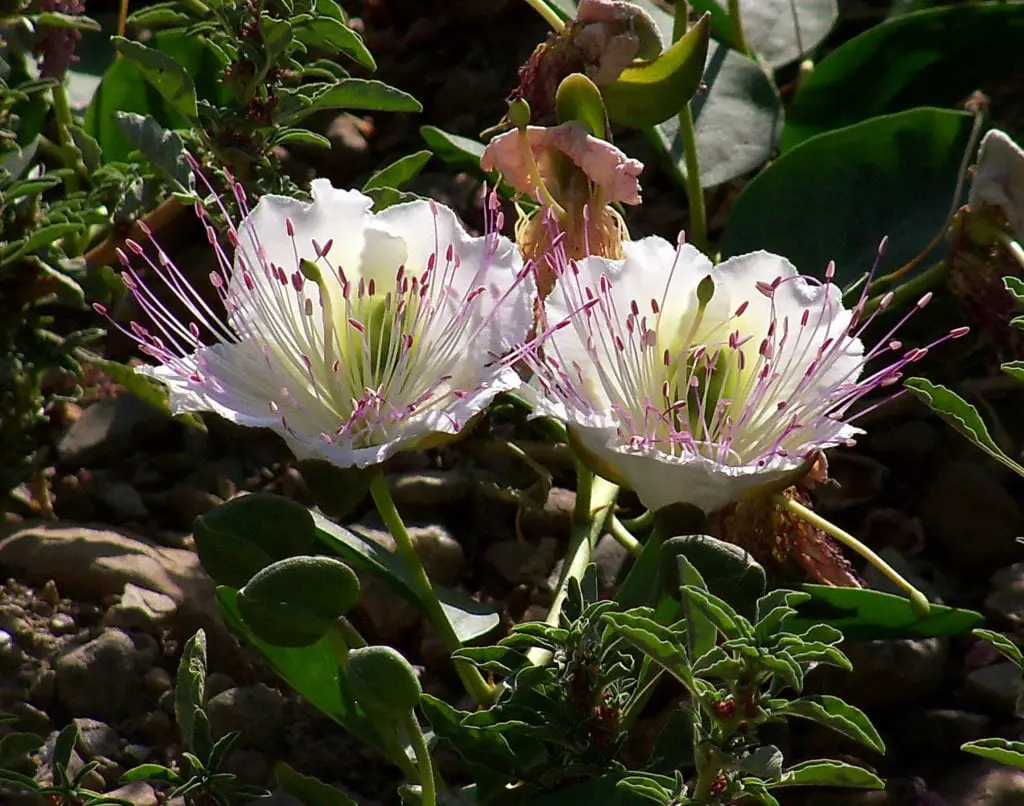

The capers They are small deciduous shrubs whose fruits are widely used in the kitchen. They have small leaves and very beautiful, large, white flowers. This plant is very easy to grow and maintain, being able to have it both in a pot and in the garden.
Would you like it know everything about her?
Characteristics of capers


Capers are plants that grow up to a meter and a half in height, native to southern Europe. Its scientific name is Spiny capersand belong to the Capparidaceae family. The leaves are simple and petiolate, at the base of which appear a pair of spiny “hooks” technically called stipules. They behave as deciduous, that is, they fall in autumn, and new ones sprout in spring.
The flowers open in spring, in the axils of the leaves. They can reach 10cm in diameterwith two white petals, four greenish sepals and purplish stamens. The flower buds, known as capers, are harvested for consumption; as well as the fruits, known as capers, which will finish maturing towards the end of the summer or the beginning of the fall.
How are they cared for?


Capers are very grateful plants that can grow in climates where rainfall is low. Indeed: they are very resistant to drought. But of course, in cultivation it is worth helping it a little to make it look pretty, and to produce a large amount of both flower buds and fruits. So that, How are they cared for?
Location
Place them in an area where the sun hits them directlybecause in semi-shadow they could not grow well.
Soil or substrate
Capers they can grow without problem in all types of soileven in the calcareous ones. On the other hand, if you are going to have it in a pot, I recommend using black peat mixed with perlite in equal parts.
Irrigation
Irrigation has to be regular: 3-4 times a week in summer and every 6 days the rest of the year. It is important to avoid that the soil or the substrate is flooded, so if you have doubts, check the humidity of the same by inserting a thin wooden stick as much as possible and, if when you extract it, it comes out practically clean, it is because the plant needs water.
Fertilizer


It is not essential, but you can pay it with any organic fertilizer liquid if it is potted, or powder if it is in the ground, such as guano or humus.
Pruning
Whenever you consider it necessary, you can trim its branches and remove those that look weak or diseased.
Rusticity
If in your area the temperature during winter drops below -2ºC, you must protect them from cold and frostfor example, wrapping them with plastic if they are soft, or introducing them inside the home if they are extreme.
Plagues and diseases
Capers are relatively resistant to pests and diseases, but They can be affected by fungi if they are watered excessively, as well as especially by red bugs.
How to reproduce capers


These are plants that reproduce by seeds or by cuttings. Let’s see how to proceed in each case:
Reproduction by seeds
To plant capers the first thing we have to do is, obviously, acquire the seeds, in spring. The fruits ripen in late summer / early autumn, but during this season it is not advisable to sow, especially if the weather is cool.
Once the temperatures remain above 15ºC, we can sow them as follows:
- We will introduce the seeds in a glass with water for 24 hoursso that the embryo that is inside it “wakes up.”
- The next day, we will fill a pot with universal substrate for plants mixed with 20% perlite, and we will water it well.
- Then we will place a maximum of two seeds per pot.
- We cover them with a little substrate (the minimum so that they are not seen with the naked eye).
- And finally, we water again.
The substrate must always be kept slightly damp, so our capers They will not take more than two-three weeks to germinate.
Reproduction by semi-woody cuttings
Semi-woody caper cuttings should be obtained in early summer. To do this, you have to:
- Cut stems 20-30cm.
- Moisten the base with water and impregnating them with rooting hormones powdered.
- Son in pot with black peat mixed with perlite in equal parts, and water.
- To make a hole in the center in the pot (one for each stem).
- Plant the stems.
The cuttings will sprout very soon, within 1 monthkeeping the substrate moist.
Uses


Capers are used above all in the kitchen, to prepare sauces, mayonnaise, salads … And they are very productive: a single plant can produce up to 3 kg of flower buds that you can use to prepare delicious dishes.
The taste of capers is intense, slightly bitter.
Medicinal properties
The medicinal properties of these plants are very, very interesting: they are diuretics, vasoconstrictor, antihemorrhoidal y tonic.
Do you dare to grow capers?

